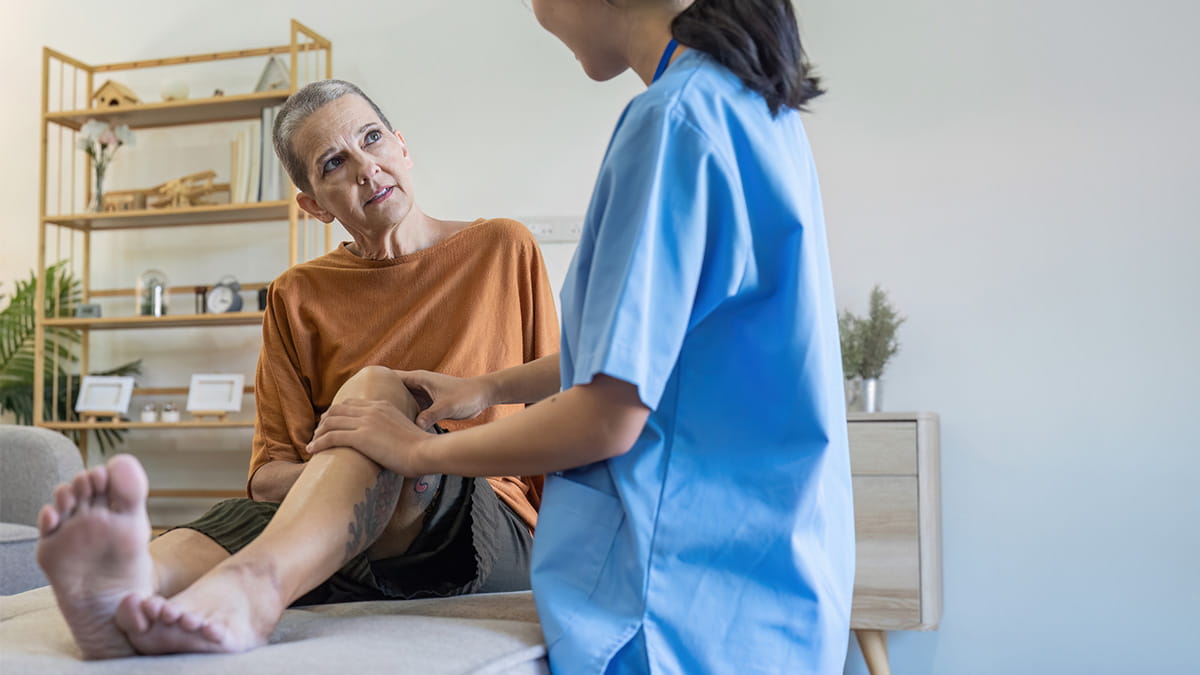Blog article
Experiencing osteoarthritis? A knee arthroscopy may not be the answer

This common procedure, involving a small camera and surgical tools inserted into the knee, is often suggested as a remedy for various knee issues. However, recent research suggests that this approach may not be as beneficial as once believed, especially for those without knee locking symptoms.2,3,4,6
In this blog, we take a look into why a knee arthroscopy might do more harm than good, exploring alternative treatments and providing guidance on making an informed decision about your joint health.
What is osteoarthritis?
Osteoarthritis is a common condition that causes painful, swollen joints, with stiffness and a reduced range of motion. It’s thought of as the ‘wear and tear’ type of arthritis.
Osteoarthritis is characterised by:
- Loss of cartilage and ligament degeneration
- Abnormal hardening of the bone under the cartilage
- The growth of bony lumps
Sometimes the breakdown of cartilage can lead to a tear, with small pieces of cartilage breaking off completely and remaining in the joint space.
What is a knee arthroscopy?
Degeneration of the knee due to osteoarthritis can cause the joint to become locked so that it becomes impossible to move the leg through a full range of motion.
In these specific instances, knee arthroscopy – a procedure whereby a tiny camera is inserted into the knee joint so that your doctor can see and potentially treat the problem – may be a reasonable first-line treatment.1
The procedure enables your health professional to visualise the knee space and can be useful when other methods of investigation, such as an MRI, don’t make it clear what the problem is.
What if my knee isn’t locking?
If there isn’t persistent locking, you might not need that arthroscopy. Thanks to an increasing number of good quality studies over the years, we now know that where there is meniscal (cartilage) damage without persistent locking, a knee arthroscopy procedure offers no benefit over exercise and medical therapy.2
Here’s a look at some of the evidence when it comes to the downsides of a knee arthroscopy:
- A randomised control trial published in 2002 in the revered New England Journal of Medicine demonstrated that in patients with osteoarthritis, outcomes following knee washout and the removal of small areas of damaged cartilage were no different to those who had undergone sham surgery (where an arthroscope was inserted into the joint to look at the degenerative changes but not used to treat them).3
- A study published in 2008, also in the New England Journal of Medicine, looked specifically at the benefits of knee arthroscopy. It concluded that the results “call into question the widespread use of arthroscopic treatment for osteoarthritis of the knee”.4
- In 2017, an international expert panel including doctors, physiotherapists, academics and patients reviewed 13 high quality clinical trials and identified no difference in long term outcome in those that underwent knee arthroscopy for uncomplicated osteoarthritis (without knee locking, for example) to those who did not undergo the procedure.4
Knee arthroscopies in Australia
Data from the Australian Atlas of Healthcare Variation 2015 has shown that in some areas of Australia, the rate of knee arthroscopy in people 55 years and over was greater than seven times those of people living elsewhere. This means not all arthroscopies are being performed in line with evidence-based care meaning a small proportion of patients are undergoing knee arthroscopy when the risk of harm outweighs the benefit.
Although the risks associated with arthroscopy may be minimal, given that so many are performed in Australia every year – almost 40,000 in the private system alone in 2020/215 – the overall number of complications may be significant. It’s been shown, for example, that for patients who underwent knee arthroscopy and meniscectomy for osteoarthritis, the risk of needing a knee replacement increased three-fold.6
It’s important for us all to remember that healthcare is a partnership between us and our doctor, and being adequately informed of the risks, benefits and likely clinical outcomes is a basic patient right and allows us to make the right decision for ourselves.
How to make an informed decision
Thankfully, we can all be more ‘health literate’ than ever these days. We’re encouraged to ask questions, consult reliable sources of information and discuss any concerns with our healthcare providers so we can weigh up all our options.
Choosing Wisely, an initiative funded by the Australian Government Department of Health and Aged Care, is a great first port of call for more information to help you make informed decisions about your health care.
When it comes to osteoarthritis, Choosing Wisely recommend to “not perform arthroscopy… for patients with symptomatic osteoarthritis of the knee and/or degenerate meniscal tear.
“There is consistent evidence to indicate that arthroscopic lavage and/or debridement to treat people for symptomatic knee osteoarthritis, and/or partial meniscectomy for patients with a degenerate meniscal tear (with or without underlying osteoarthritis), is no more effective than placebo surgery or non-operative alternatives.”
For more information, head to the Choosing Wisely website.
If not an arthroscopy, how do I treat my osteoarthritis?
While there is no cure for osteoarthritis, management of the condition typically involves a combination of treatments aimed at reducing pain, improving joint function, and slowing the progression of the disease.
These include regular exercise; achieving and maintaining a healthy weight; special devices and footwear like walking aids, knee braces, and insoles; and pain relief options like heat packs, paracetamol, and non-steroidal anti-inflammatory medicines (NSAIDs).7
How can HBF help with osteoarthritis?
The GLA:D® Program: Delivered in partnership with HBF Physio and other approved program providers, the GLA:D® Program is designed to reduce pain, improve strength and help eligible members move more confidently. Evidence has shown participants experience an average pain reduction of 33% after completing the program.8*
Osteoarthritis Healthy Weight for Life: Delivered in three phases, this 18-week program is designed to promote long-lasting behaviour change, supporting weight loss, increased mobility and better pain management for eligible members. You’ll be supported by a progressive dietary plan aimed at achieving sustainable weight loss and improved eating habits.**


